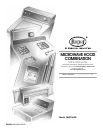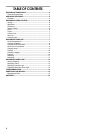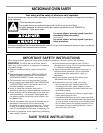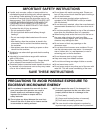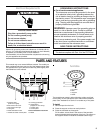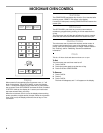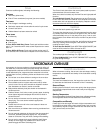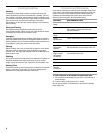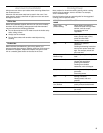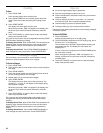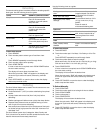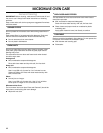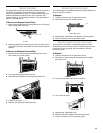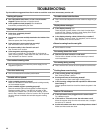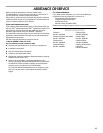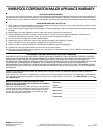
7
Tones
Tones are audible signals, indicating the following:
One tone
■ Valid entry (short tone)
■ End of Timer countdown (long tone) (on some models)
Two tones
■ End of stage in multistage cooking
■ Reminder, repeat each minute after the end-of-cycle tones
■ Control Lock active
■ Hidden feature has been entered or exited
Three tones
■ Invalid entry
Four tones
■ End of cycle
To Turn Off/On Valid Entry Tones: Touch and hold the number
pad “1” for 5 seconds until 2 tones sound. Repeat to turn tones
back on.
To Turn Off/On All Tones: Touch and hold the number pad “2”
for 5 seconds until 2 tones sound. Repeat to turn tones back on.
Control Lock
The Control Lock shuts down the control panel pads to prevent
unintended use of the microwave oven.
When the control is locked, only the Vent Fan and Light pads will
function.
To Lock/Unlock Control: The microwave oven and Timer must
be off. Touch and hold OFF/CANCEL for 5 seconds until 2 tones
sound and a lock icon appears on the display. Repeat to unlock
and remove the lock icon from display.
Vent Fan
The vent fan has 2 speeds: high and low.
To protect the microwave oven, if the temperature from the range
or cooktop below the microwave oven gets too hot, the vent fan
will automatically turn on. It may stay on for up to 1 hour to cool
the microwave oven. When this occurs, the Vent Fan pad will not
function.
The exhaust fan is also the cooling fan, and will start at low speed
when any cooking function begins. It will remain on until the
cooking function is over.
To Turn Vent Fan On/Off: Touch VENT FAN HIGH/LOW/OFF pad
once for HIGH, twice for LOW or 3 times for OFF.
Cooktop Light
The cooktop light has 3 settings: on, night and off.
To Turn On/Night/Off: Touch LIGHT ON/NIGHT/OFF repeatedly
to cycle through settings.
MICROWAVE OVEN USE
A magnetron in the oven produces microwaves which reflect off
the metal floor, walls and ceiling and pass through the turntable
and appropriate cookware to the food. Microwaves are attracted
to and absorbed by fat, sugar and water molecules in the food,
causing them to move, producing friction and heat which cooks
the food.
■ Do not lean on or allow children to swing on the oven door.
■ Do not operate microwave oven when it is empty.
■ The turntable must be in place and correct side up when
oven is in use. Do not use if turntable is chipped or broken.
See “Assistance or Service” section to reorder.
■ Baby bottles and baby food jars should not be heated in
microwave oven.
■ Clothes, flowers, fruit, herbs, wood, gourds, paper, including
brown paper bags and newspaper should not be dried in
microwave oven.
■ Do not use the microwave oven for canning, sterilizing or
deep frying. The oven cannot maintain appropriate
temperatures.
■ Paraffin wax will not melt in the oven because it does not
absorb microwaves.
■ Use oven mitts or pot holders when removing containers from
microwave oven.
■ Do not overcook potatoes. At the end of the recommended
cook time, potatoes should be slightly firm. Let potatoes
stand for 5 minutes. They will finish cooking while standing.
■ Do not cook or reheat whole eggs inside the shell. Steam
buildup in whole eggs may cause them to burst. Cover
poached eggs and allow a standing time.
Food Characteristics
When microwave cooking, the amount, size and shape, starting
temperature, composition and density of the food affect cooking
results.
Amount of Food
The more food heated at once, the longer the cook time. Check
for doneness and add small increments of time if necessary.
Size and Shape
Smaller pieces of food will cook more quickly than larger pieces,
and uniformly shaped foods cook more evenly than irregularly
shaped food.
Starting Temperature
Room temperature foods will heat faster than refrigerated foods,
and refrigerated foods will heat faster than frozen foods.
Composition and Density
Foods high in fat and sugar will reach a higher temperature and
heat faster than other foods. Heavy, dense foods, such as meat
and potatoes, require a longer cook time than the same size of a
light, porous food, such as cake.



